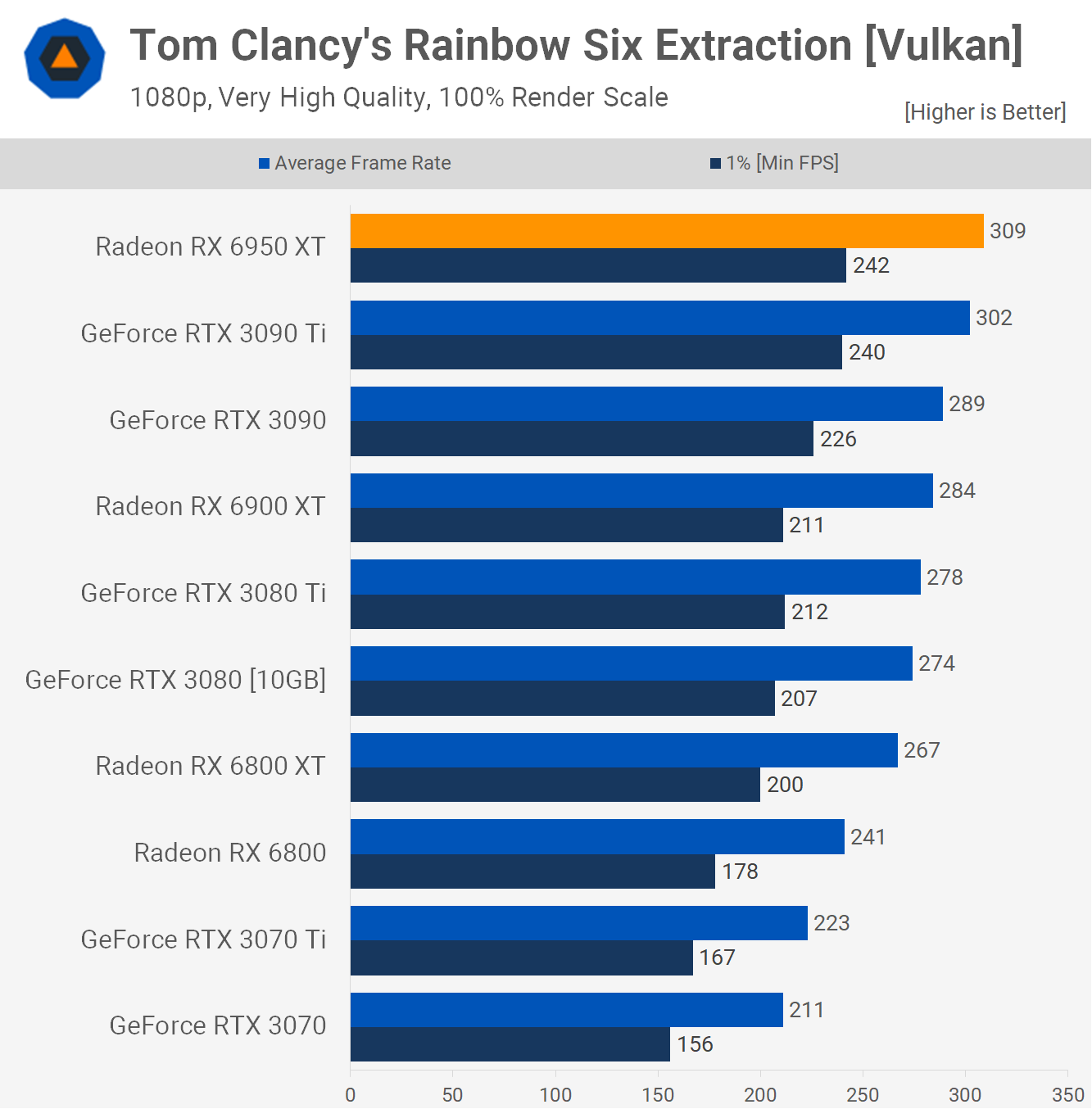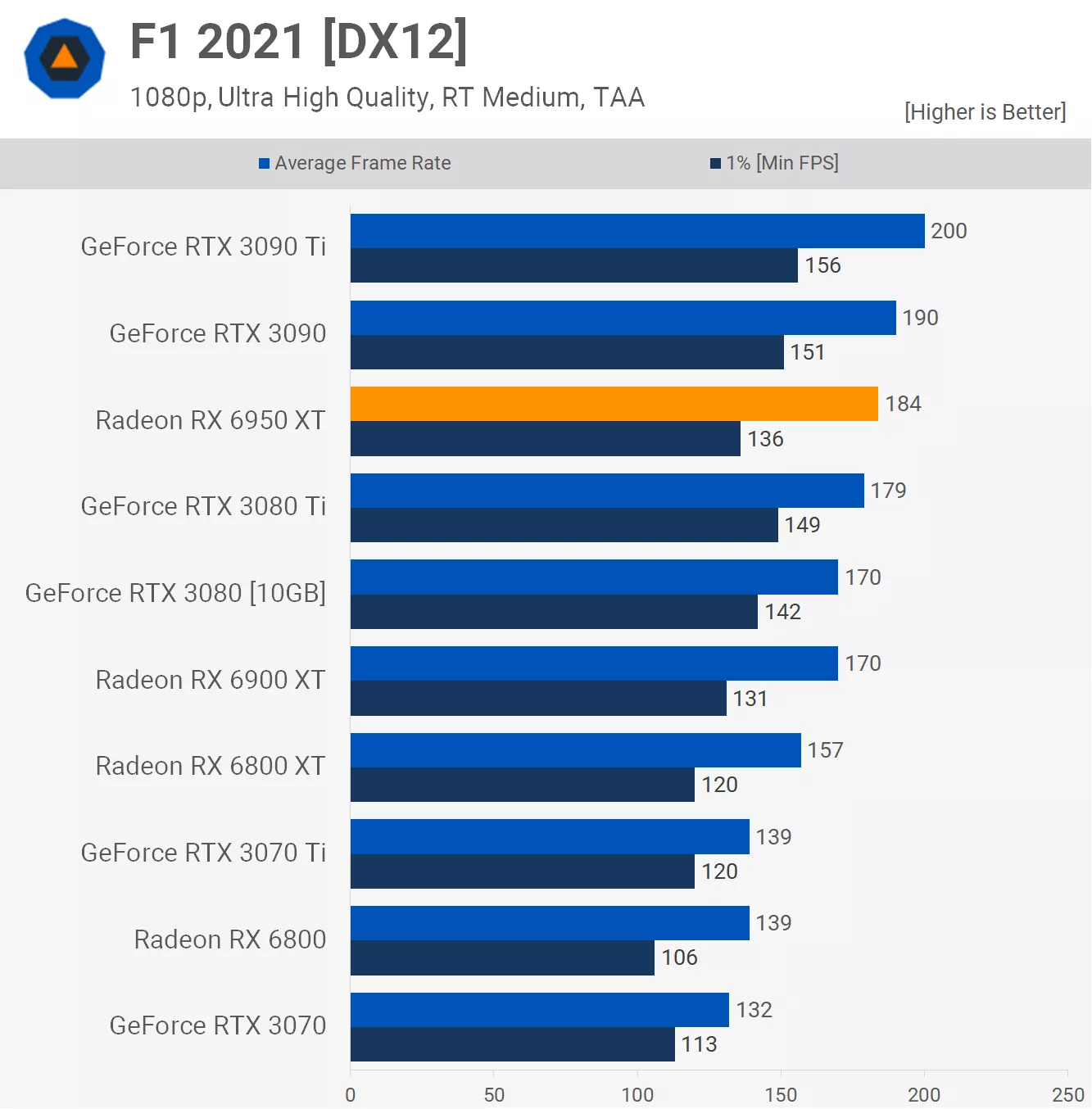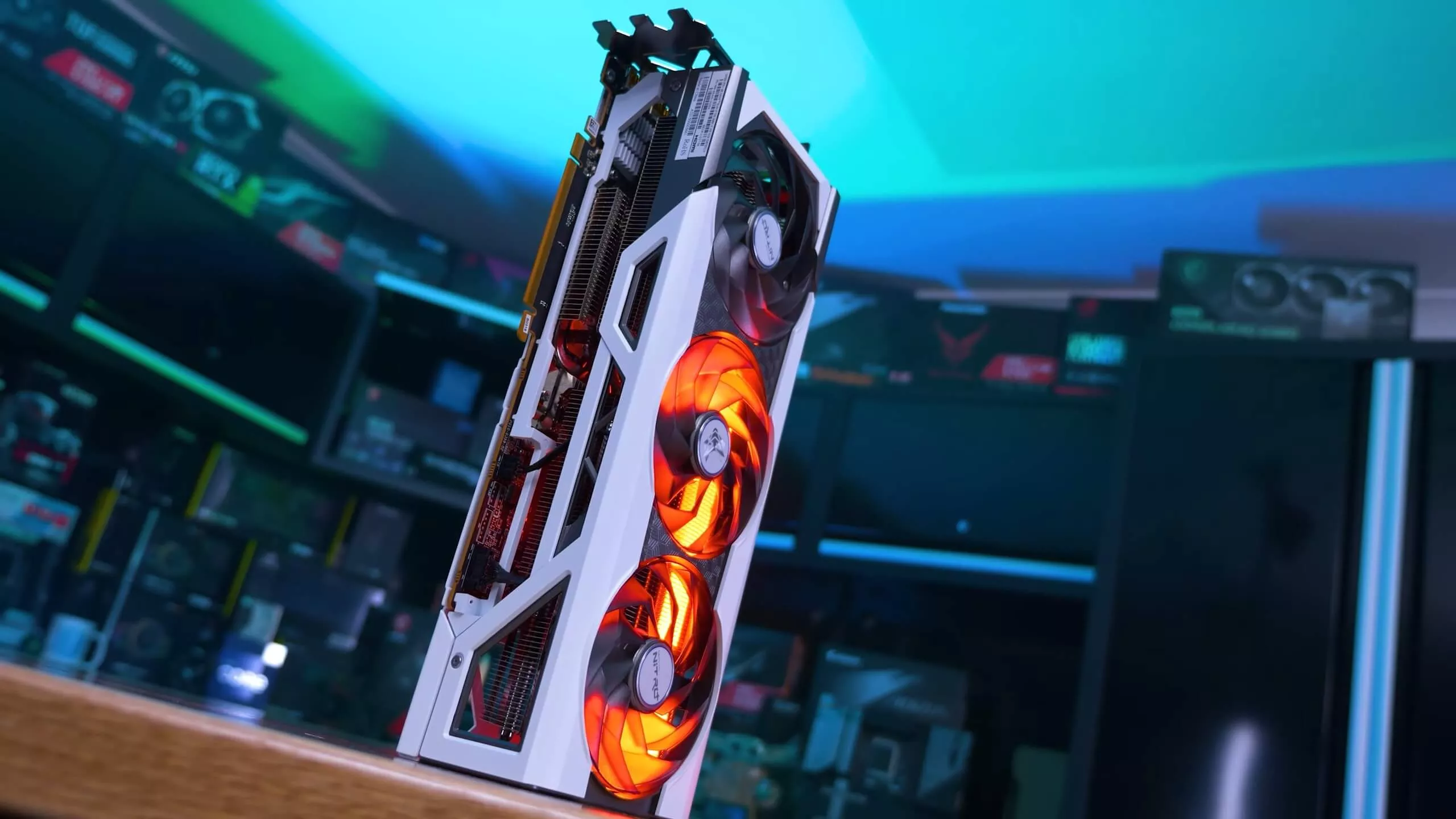The new Radeon RX 6950 XT flagship is once again a minor refresh in AMD’s GPU lineup. Like the 6650 XT and 6750 XT refreshes, the 6950 XT is based on the same die as the original model, the Navi 21-based 6900 XT. The core count is the same as before, with a tiny 3% core clock uplift and a boost to memory bandwidth which has been increased by 13% thanks to the use of 18 Gbps GDDR6 memory.
Based on those specs, we’re expecting typical performance gains over the 6900 XT to be in the vicinity of 5-10%, which should help AMD in their flagship halo product battle with Nvidia. In this case, AMD has increased the MSRP from $1,000 to $1,100 which doesn’t bother me all that much since this was never a value oriented product, hence I was more concerned with the price increase on the 6650 XT and 6750 XT models.
As of writing, the 6900 XT and 6800 XT are almost within the same price range and although the new 6950 XT is likely going to be more expensive, in terms of value it’s probably going to be only marginally worse with the potential to be worlds better than Nvidia’s high-end options since GeForce GPUs are still selling considerably higher than MSRPs.

For testing all AMD and Nvidia GPUs we have clocked them at the official spec with no factory overclocking. All the data in this review is fresh, collected on a machine powered by the Ryzen 7 5800X3D with 32GB of dual-rank, dual-channel DDR4-3200 CL14 memory on the Asus ROG Crosshair VIII Extreme motherboard using the latest BIOS.

We’ve tested 11 games at 1080p, 1440p and 4K, of which we’ll go into more detail for a few of them before looking at our 11 game average data and cost per frame analysis.
Benchmarks
Starting with Rainbow Six Extraction, we find the 6950 XT to be chart topping at 1080p with 309 fps, a 10% increase over the 6900 XT. That allowed it to budge ahead of the much more expensive RTX 3090 Ti at this lower resolution and it’s an 11% boost over the RTX 3080 Ti, a GeForce GPU that’s still more expensive than the 6950 XT.


Jumping up to 1440p quickly changes the standings and now the 6950 XT is seen matching the original RTX 3090 with 206 fps on average, an 11% boost over the original 6900 XT. It was also just 4% faster than the RTX 3080 Ti, but 7% slower than the RTX 3090 Ti, though from a value standpoint that’s not a bad result for AMD given the 6950 XT is cheaper than both GeForce GPUs.

Then at 4K the Ampere RTX GPUs take over and even the original 10GB version of the RTX 3080 is faster than the new 6950 XT in this title.
This is not a bad result for AMD in terms of value though. The RTX 3080 Ti, for example, might be 11% faster, but it also costs 16% more, while the RTX 3090 Ti costs 82% more for a 28% increase at 4K in this title.

Next we have Watch Dogs: Legion and again the 6950 XT tops the chart at 1080p, averaging 168 fps or 6% faster than the 6900 XT, and a mere 6% faster than what should be the much cheaper 6800 XT, though in reality it isn’t.

Even at 1440p, the Radeon GPUs maintain a decent performance advantage over GeForce competitors and here the 6950 XT was 12% faster than the RTX 3090 Ti, 21% faster than the RTX 3090 and 23% faster than the RTX 3080 Ti. Those are impressive margins, though it was just 5% faster than the original 6900 XT.

Then at 4K, the RTX GPUs come back hard, but still the 6950 XT was able to maintain top spot, edging out the RTX 3090 Ti by just a few frames. Here we’re looking at an 11% performance boost over the 6900 XT, which is not a bad result and in line with the price increase.

Moving on to the Shadow of the Tomb Raider, the 6950 XT is able to command top spot at 1080p, delivering 201 fps on average, which is an 8% increase over the 6900 XT. It’s also a 5% boost over the RTX 3090 Ti, 12% over the RTX 3090, and 13% over the RTX 3080 Ti.

The margins remained the same at 1440p. The 6950 XT edged out the RTX 3090 Ti by a tiny margin and boosted performance over the 6900 XT by 11%.

As usual, it’s 4K that proves to be a challenge for RNDA2 in its battle with Ampere and now it’s the RTX 3090 Ti that leads the 6950 XT by an 8% margin. We’re looking at a 12% performance boost for the 6950 XT over the 6900 XT, and that was enough to put it just ahead of the RTX 3090 and 3080 Ti.

The Radeon GPUs don’t fare quite as well in The Outer Worlds as evidenced by these 1080p results. The 6950 XT was only slightly slower than the RTX 3090 Ti, but this is the first sample we have where it wasn’t faster at 1080p. We’re looking at similar performance between the RTX 3080 Ti, 6900 XT, RTX 3090, 6950 XT and RTX 3090 Ti.

Increasing the resolution to 1440p reduces how CPU bound The Outer Worlds testing is and now we’re seeing an 8% performance increase from the 6900 XT to the 6950 XT. The RTX 3090 Ti is 10% faster than the 6950 XT, though right now that’s a GPU over 80% more expensive.

Finally at 4K, the 6950 XT is only able to match the RTX 3080 10GB despite offering a 12% boost over the 6900 XT. The RTX 3090 Ti is now 22% faster than the 6950 XT as well.

We’re going to wrap up the individual game data with a look at F1 2021, and of course, we’ll start with 1080p. We find another example where the 6950 XT is unable to beat the RTX 3090 series at 1080p, this time trailing the RTX 3090 Ti by an 8% margin, though it was a little faster than the 3080 Ti which is technically a good result.

Increasing the resolution to 1440p sees the RTX 3080 Ti close in on the 6950 XT though the margin to the RTX 3090 remains much the same while the 3090 Ti was 8% faster. We’re also looking at a 12% increase for the 6950 XT over the 6900 XT, or about as good as you could hope for.

Finally at 4K the 6950 XT falls further behind the RTX 3080 Ti and trails the RTX 3090 Ti by a 16% margin, and that’s despite boosting performance over the original 6900 XT by 13%.
Power Consumption
Looking at total system power, the 6950 XT pushed total usage to 528 watts, and that’s a massive 19% increase in total power usage when compared to the 6900 XT for what looked like around 10% more performance. Efficiency certainly has gone out the window with these overclocked models.

We thought the power usage of the 3090 Ti was pretty horrible, but the 6950 XT is only dropping system usage by 8%. So if you care about power usage and efficiency, it probably goes without saying, but these overclocked-to-the-max models won’t be for you.
Performance Summary
Starting with the 1080p fps average gaming data we see that for low resolution gamers targeting maximum fps — we imagine mostly competitive shooter type gamers — the Radeon RX 6950 XT is about as good as it gets for out of the box performance.

That said, we are only talking about a 3% boost over the RTX 3090 Ti. The Radeon is around 45% cheaper right now though, so that’s a win for AMD. When compared to the 6900 XT though we’re only looking at a 6% boost, so certainly not worth the premium.

At 1440p, the 6950 XT and RTX 3090 Ti are neck and neck with 149 fps on average across the 11 games tested. That means a 9% performance boost for the 6950 XT over the 6900 XT and an 11% increase over the more expensive RTX 3080 Ti.

Then at 4K the RTX 3090 Ti takes over, beating the 6950 XT by a 7% margin. Still the 6950 XT was just able to edge out the RTX 3090 and 3080 Ti, with a 12% boost over the 6900 XT.
Cost Per Frame
We’ll set up our cost per frame analysis with the mythical MSRP, just to visualize what would be, even if it’s not relevant to the current market.
Had these GPUs been available at their MSRP, this is how the RDNA2 and Ampere generations would have stacked up at the high-end using our 1440p data…

In this wishful scenario, AMD and Nvidia would have been evenly matched in terms of performance and value. Looking at the Radeon RX 6800 XT and GeForce RTX 3080 10GB, a slight premium for the RTX 3080 can be seen, but that product probably does command a slight premium.
Where the value goes out the window is with the AMD and Nvidia refresh products, and of course, the “halo” products. For rasterization performance, the 6900 XT is much better value than the RTX 3090, saving you around 28% per frame, but for high resolution gaming the RTX 3090 is the faster halo product with better features.
Interestingly, the 6950 XT is slightly better value than the original model at the MSRP, dropping the cost per frame by about 2%, or essentially they are about the same. The RTX 3090 Ti costs 70% more per frame than the 6950 XT based on the MSRP. Now let’s move on to real-world pricing…

Here’s a reality check at the high-end. The 6950 XT has been listed at the MSRP at retailers and that makes sense given the 6900 XT is selling for just below the MSRP as we found multiple models available for $950. Quite surprisingly, the 6800 XT is still up around $860 which is a 76% price increase from the 6700 XT, when in reality it should be more like 35%. Keep that in mind as we’ll discuss this further towards the end of the review.
AMD’s high-end lineup is in line with Nvidia’s sensible high-end options, namely the RTX 3080 10GB. Pricing for GeForce GPUs gets ridiculous once we reach the RTX 3080 Ti and beyond. From the 6950 XT, the cost per frame jumps up by 24% for the 3080 Ti, then 70% for the RTX 3090 and 3090 Ti. So if you had $1,000 or more to spend on a high-end GPU, but you still wanted to make the most out of your buck, then you’d go with the 6900 XT or maybe the 6950 XT as it’s only 4% more per frame.
Cooling
Taking a quick look at the thermal and clock characteristics of the MSI and Sapphire 6950 XT models that we have on hand. Starting with the 6950 XT Gaming X Trio we have a typical looking card from MSI, we’d summarise it as a quality but basic design, a triple slot triple fan card with the typical Gaming X Trio looks.

Performance wise, it saw a peak GPU temperature of 77C when installed inside our Corsair Obsidian 500D test case with a room temperature of 21C, a good result given the power consumption of the 6950 XT GPU. The fans spinned at 2000 RPM to maintain that temperature and could just be heard over our case fans. That’s a relatively quiet high-end graphics card in our book. The cores typically clocked at 2470 MHz with GPU power around 332 watts.

The Sapphire 6950 XT Nitro+ Pure is a massive triple fan four-slot monster and in our opinion this card looks amazing. This model features dual BIOS support which is essential for any graphics card priced over $300 in our opinion, let alone these ones, so it was disappointing to see that MSI omitted the feature.
Thankfully the Nitro+ Pure doesn’t and out of the box using the primary mode this is how the card behaves… the GPU peaked at 76C with a fan speed of just 1200 RPM making it noticeably quieter than the MSI model. It did clock slightly lower at 2350 MHz, a 5% reduction, when using the standard operating BIOS.

Switching to the “OC BIOS” saw the peak GPU temperature decline ever so slightly as the fan speed increased to 1400 RPM, but even here the Nitro+ Pure couldn’t be heard over the case fans. The GPU clock speed averaged 2430 MHz, similar to the Gaming X Trio at a lower operating volume and temperature.
The Sapphire 6950 XT Nitro+ Pure is an impressive looking graphics card, that’s also beastly. It costs $200 more at $1,300, but if you’re interested in a 6950 XT then we feel these higher-end models make more sense as it’s more of a “go big or go home” type mentality with halo products.
What We Learned
The Radeon RX 6950 XT does well against the RTX 3090 Ti at a dramatically lower price point, so in that sense it does a great job and is an excellent competitor. It’s also not bad in terms of value next to the original 6900 XT.

It’s a bit difficult to go hard after AMD for raising prices in this segment given how much cheaper Radeon GPUs are than their GeForce competitors. Of course, AMD would love you to pay more, but they simply don’t have the mindshare to get away with it the same way Nvidia can. In other words, AMD is not intentionally doing gamers a favor, but it works out kind of nice for consumers that don’t have eyes only for the green team.

We should note though, there’s still some market manipulation going with GPUs when multiple products are sharing the same silicon. As we noted in the cost per frame analysis, the more affordable RX 6800 is meant to cost 21% more than the 6700 XT, while the 6800 XT is meant to cost 35% more. However, the RX 6800 currently costs 55% more, while the 6800 XT costs 76% more. The simple explanation is that the 6800 and 6900 series share the same silicon.
So you see, rather than sell you their 520mm2 Navi 21 silicon for around $590, which is where the RX 6800 should be, AMD is limiting supply of the 6800 series which increases the price, pushing the 6800 up to $760 and in turn making the RX 6900 series appear more reasonable.

But why stop there? They can and have gone a step further with the Radeon 6950 XT to make an additional $100 per unit sold. As long as the demand is there, you can expect 6800, 6800 XT and we suspect even 6900 XT supply to be very limited. We’re not fans of this somewhat artificial inflation of GPU pricing, but while gamers continue to purchase products like the RTX 3090 and RX 6900 series, AMD and Nvidia will continue to divert as much supply as possible to their premium lineups.

